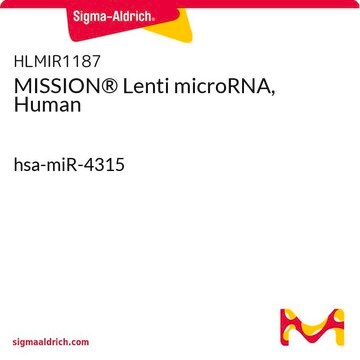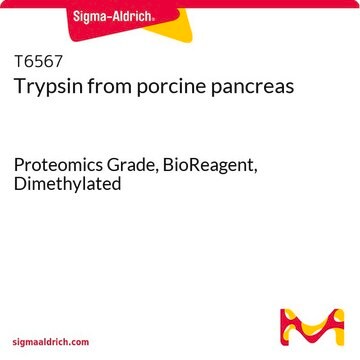The solution stability of this product in corn oil has not been determined. However, other sources state that solutions of tamoxifen in corn oil can be stored at 4°C for up to a week.
T5648
Tamoxifène
≥99% (TLC), powder, PKC inhibitor
Synonyme(s) :
trans-Tamoxifène, (Z)-1-(p-Diméthylaminoéthoxyphényl)-1,2-diphényl-1-butène, (Z)-2-[4-(1,2-Diphénylbut-1-ényl)phénoxy]-N,N-diméthyléthanamine
About This Item
Produits recommandés
Nom du produit
Tamoxifène, ≥99%
Stérilité
(Not packaged in a sterile environment)
Essai
≥99%
Pf
97-98 °C (lit.)
Solubilité
H2O: insoluble <0.1% at 20 °C
chloroform: soluble 50 mg/mL, clear, colorless to faintly yellow
2-propanol: soluble
DMSO: soluble
ethanol: soluble
methanol: soluble
propylene glycol: soluble
Spectre d'activité de l'antibiotique
neoplastics
Mode d’action
enzyme | inhibits
Auteur
AstraZeneca
Température de stockage
2-8°C
Chaîne SMILES
CC\C(c1ccccc1)=C(/c2ccccc2)c3ccc(OCCN(C)C)cc3
InChI
1S/C26H29NO/c1-4-25(21-11-7-5-8-12-21)26(22-13-9-6-10-14-22)23-15-17-24(18-16-23)28-20-19-27(2)3/h5-18H,4,19-20H2,1-3H3/b26-25-
Clé InChI
NKANXQFJJICGDU-QPLCGJKRSA-N
Informations sur le gène
human ... CYP1A2(1544) , EBP(10682) , ESR1(2099) , ESR2(2100) , ESRRA(2101)
rat ... Ar(24208) , Esr1(24890)
Vous recherchez des produits similaires ? Visite Guide de comparaison des produits
Description générale
Ce dérivé de triphényléthylène non stéroïdien supprime la croissance tumorale et a été décrit comme un agent cancérigène et tératogène chez les animaux. Le tamoxifène pourrait aussi protéger les os contre la perte osseuse due à une carence œstrogénique et abaisser le cholestérol plasmatique ; il a également été impliqué dans la carcinogenèse hépatique chez le rat. Parmi ses autres effets, on peut citer la réduction du taux plasmatique du facteur de croissance analogue à l'insuline, l'induction de la sécrétion de facteur de croissance transformant β par les cellules environnant les cellules cancéreuses et l'inhibition de la peroxydation des lipides membranaires, probablement en diminuant la fluidité des membranes.
Application
- dans un test au (3-(4,5-diméthylthiazol-2-yl)-5-(3-carboxyméthoxyphényl)-2-(4-sulfophényl)-2H-tétrazolium), ou MTS, et un test de coloration au cristal violet pour accéder à la viabilité cellulaire.[2] [3]
- pour induire l'ablation de Dicer chez des souris du type Dicer conditionnel, afin d'étudier les effets de l'absence de Dicer sur la différenciation et la fonction des adipocytes.[4]
- pour étudier ses effets biologiques sur une lignée cellulaire Jurkat résistant au glucocorticoïdes (GC), dérivée d'une leucémie lymphoblastique aiguë à cellules T (T-ALL).[5]
- pour étudier les effets physiologiques d'un traitement par tamoxifène sur la zone préoptique (POA) de l'hypothalamus avec médiation par le récepteur alpha des œstrogènes (ERα) chez la souris.[6]
- pour induire une activité recombinase Cre en vue de la manipulation d'un gène.[7]
- pour faciliter la recombinaison de l'allèle ect2flox dans des organes de souris.
- pour étudier ses effets sur l'activation microgliale induite par les lipopolysaccharides (LPS).
Actions biochimiques/physiologiques
Caractéristiques et avantages
Notes préparatoires
Stockage et stabilité
Autres remarques
Mention d'avertissement
Danger
Mentions de danger
Conseils de prudence
Classification des risques
Aquatic Acute 1 - Aquatic Chronic 1 - Carc. 1A - Repr. 1B
Code de la classe de stockage
6.1C - Combustible acute toxic Cat.3 / toxic compounds or compounds which causing chronic effects
Classe de danger pour l'eau (WGK)
WGK 3
Point d'éclair (°F)
Not applicable
Point d'éclair (°C)
Not applicable
Équipement de protection individuelle
Eyeshields, Gloves, type P3 (EN 143) respirator cartridges
Faites votre choix parmi les versions les plus récentes :
Certificats d'analyse (COA)
Vous ne trouvez pas la bonne version ?
Si vous avez besoin d'une version particulière, vous pouvez rechercher un certificat spécifique par le numéro de lot.
Déjà en possession de ce produit ?
Retrouvez la documentation relative aux produits que vous avez récemment achetés dans la Bibliothèque de documents.
Les clients ont également consulté
Articles
We presents an article on Autophagy in Cancer Promotes Therapeutic Resistance
Discover Bioactive Small Molecules for ADME/Tox
Discover Bioactive Small Molecules for ADME/Tox
Discover Bioactive Small Molecules for ADME/Tox
Chromatograms
application for HPLC, application for SPE-
Tamoxifen was dissolved in corn oil (20mg/ml concentration). Can this solution be stored long term and how? Thank you.
1 answer-
Helpful?
-
-
Is this product pharmaceutical grade?
1 answer-
This product is intended for research use only. At this time, a pharmaceutical-grade product option is not available.
Helpful?
-
-
Hello, Thank you for your product. According to my protocol, I have to dissolve Tamoxifen in the corn oil at the final concentration of 40 mg/ml and feed my mice with that. However, it's insoluble. How can I resolve it? Thank you, Hossein
1 answer-
This product is soluble in chloroform (50 mg/mL, clear, colorless to faintly yellow), 2-propanol, DMSO (10 mM), ethanol, methanol and propylene glycol. Kindly review the information on the product datasheet available at this link: https://www.sigmaaldrich.com/deepweb/assets/sigmaaldrich/product/documents/389/852/t5648pis.pdf
Corn oil has also been used as a vehicle for tamoxifen as cited by Whitfield J, Littlewood T, Soucek L. Tamoxifen administration to mice. Cold Spring Harb Protoc. 2015 Mar 2;2015(3):269-71. doi: 10.1101/pdb.prot077966. PMID: 25734062; PMCID: PMC6773604. Kindly also review the details at this link: https://www.jax.org/research-and-faculty/resources/cre-repository/tamoxifen
Helpful?
-
-
If I want to use 20mg of tamoxifen, could I only dissolve part of tamoxifen and then store the rest of the powder at refrigerator? Or do I have to dissolve all vial at once?
1 answer-
Tamoxifen is relatively stable. Any required amount can be weighed up for use as needed and the bottle resealed. The powder should be stable for at least two years when stored desiccated at 2-8C, and protected from light.
Helpful?
-
-
Is this product sterile?
1 answer-
This product is not packaged in a sterile environment.
Helpful?
-
-
How do I find the expiration date of the bottle of Product No T5648, Tamoxifen, in my possession?
1 answer-
According to Sigma Quality Control Data, T5648 (tamoxifen) should be stable for at least two years if stored dessicated at 2-8°C in the dark. However, there is not an established expiration or retest date for Tamoxifen. This product is guaranteed for 1 year from shipment, if stored correctly and unopened.
Helpful?
-
-
What is the Department of Transportation shipping information for this product?
1 answer-
Transportation information can be found in Section 14 of the product's (M)SDS.To access the shipping information for this material, use the link on the product detail page for the product.
Helpful?
-
-
What is the solubility of tamoxifen, Product No. T5648?
1 answer-
Tamoxifen is tested for solubility in chloroform at a concentration of 50mg/mL. This yields a colorless to faint yellow solution. Tamoxifen is practically insoluble in water. It has been reported to be soluble in methanol, ethanol, 2-propanol and propylene glycol. This product is also reported to be soluble in DMSO at 10mM concentration. Reference for DMSO solubility: Wong, K.R., et al., Am. J. Physiol. Heart Circ. Physiol., 277, H1403-H1409 (1999). Please also see the product information sheet (under Documents, above) for more information on the solubility of this product.
Helpful?
-
-
What is the stability of tamoxifen (e.g., Product No. T5648) once in solution?
1 answer-
Solutions of tamoxifen are sensitive to UV light. According to C.A. O'Brian et al., [Cancer Res. 45, 2462 (1985)], tamoxifen when dissolved in DMSO can be stored at -20°C in the dark. We generally recommend making the solution fresh right before each use.
Helpful?
-
Active Filters
Notre équipe de scientifiques dispose d'une expérience dans tous les secteurs de la recherche, notamment en sciences de la vie, science des matériaux, synthèse chimique, chromatographie, analyse et dans de nombreux autres domaines..
Contacter notre Service technique















